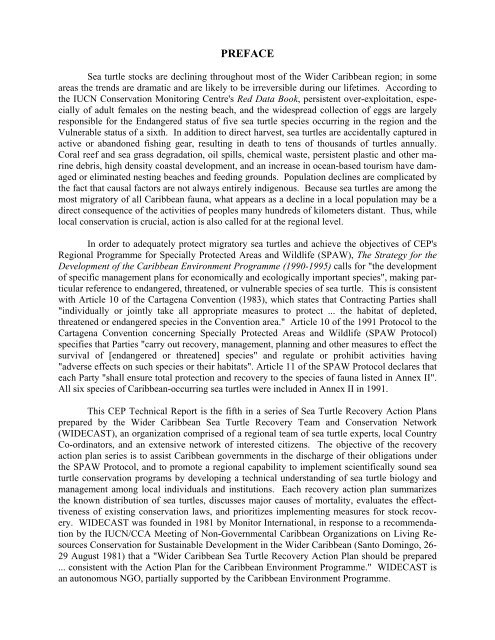Sea Turtle Recovery Action Plan for St. Kitts and Nevis - WIDECAST
Sea Turtle Recovery Action Plan for St. Kitts and Nevis - WIDECAST
Sea Turtle Recovery Action Plan for St. Kitts and Nevis - WIDECAST
You also want an ePaper? Increase the reach of your titles
YUMPU automatically turns print PDFs into web optimized ePapers that Google loves.
PREFACE<br />
<strong>Sea</strong> turtle stocks are declining throughout most of the Wider Caribbean region; in some<br />
areas the trends are dramatic <strong>and</strong> are likely to be irreversible during our lifetimes. According to<br />
the IUCN Conservation Monitoring Centre's Red Data Book, persistent over-exploitation, especially<br />
of adult females on the nesting beach, <strong>and</strong> the widespread collection of eggs are largely<br />
responsible <strong>for</strong> the Endangered status of five sea turtle species occurring in the region <strong>and</strong> the<br />
Vulnerable status of a sixth. In addition to direct harvest, sea turtles are accidentally captured in<br />
active or ab<strong>and</strong>oned fishing gear, resulting in death to tens of thous<strong>and</strong>s of turtles annually.<br />
Coral reef <strong>and</strong> sea grass degradation, oil spills, chemical waste, persistent plastic <strong>and</strong> other marine<br />
debris, high density coastal development, <strong>and</strong> an increase in ocean-based tourism have damaged<br />
or eliminated nesting beaches <strong>and</strong> feeding grounds. Population declines are complicated by<br />
the fact that causal factors are not always entirely indigenous. Because sea turtles are among the<br />
most migratory of all Caribbean fauna, what appears as a decline in a local population may be a<br />
direct consequence of the activities of peoples many hundreds of kilometers distant. Thus, while<br />
local conservation is crucial, action is also called <strong>for</strong> at the regional level.<br />
In order to adequately protect migratory sea turtles <strong>and</strong> achieve the objectives of CEP's<br />
Regional Programme <strong>for</strong> Specially Protected Areas <strong>and</strong> Wildlife (SPAW), The <strong>St</strong>rategy <strong>for</strong> the<br />
Development of the Caribbean Environment Programme (1990-1995) calls <strong>for</strong> "the development<br />
of specific management plans <strong>for</strong> economically <strong>and</strong> ecologically important species", making particular<br />
reference to endangered, threatened, or vulnerable species of sea turtle. This is consistent<br />
with Article 10 of the Cartagena Convention (1983), which states that Contracting Parties shall<br />
"individually or jointly take all appropriate measures to protect ... the habitat of depleted,<br />
threatened or endangered species in the Convention area." Article 10 of the 1991 Protocol to the<br />
Cartagena Convention concerning Specially Protected Areas <strong>and</strong> Wildlife (SPAW Protocol)<br />
specifies that Parties "carry out recovery, management, planning <strong>and</strong> other measures to effect the<br />
survival of [endangered or threatened] species" <strong>and</strong> regulate or prohibit activities having<br />
"adverse effects on such species or their habitats". Article 11 of the SPAW Protocol declares that<br />
each Party "shall ensure total protection <strong>and</strong> recovery to the species of fauna listed in Annex II".<br />
All six species of Caribbean-occurring sea turtles were included in Annex II in 1991.<br />
This CEP Technical Report is the fifth in a series of <strong>Sea</strong> <strong>Turtle</strong> <strong>Recovery</strong> <strong>Action</strong> <strong>Plan</strong>s<br />
prepared by the Wider Caribbean <strong>Sea</strong> <strong>Turtle</strong> <strong>Recovery</strong> Team <strong>and</strong> Conservation Network<br />
(<strong>WIDECAST</strong>), an organization comprised of a regional team of sea turtle experts, local Country<br />
Co-ordinators, <strong>and</strong> an extensive network of interested citizens. The objective of the recovery<br />
action plan series is to assist Caribbean governments in the discharge of their obligations under<br />
the SPAW Protocol, <strong>and</strong> to promote a regional capability to implement scientifically sound sea<br />
turtle conservation programs by developing a technical underst<strong>and</strong>ing of sea turtle biology <strong>and</strong><br />
management among local individuals <strong>and</strong> institutions. Each recovery action plan summarizes<br />
the known distribution of sea turtles, discusses major causes of mortality, evaluates the effecttiveness<br />
of existing conservation laws, <strong>and</strong> prioritizes implementing measures <strong>for</strong> stock recovery.<br />
<strong>WIDECAST</strong> was founded in 1981 by Monitor International, in response to a recommendation<br />
by the IUCN/CCA Meeting of Non-Governmental Caribbean Organizations on Living Resources<br />
Conservation <strong>for</strong> Sustainable Development in the Wider Caribbean (Santo Domingo, 26-<br />
29 August 1981) that a "Wider Caribbean <strong>Sea</strong> <strong>Turtle</strong> <strong>Recovery</strong> <strong>Action</strong> <strong>Plan</strong> should be prepared<br />
... consistent with the <strong>Action</strong> <strong>Plan</strong> <strong>for</strong> the Caribbean Environment Programme." <strong>WIDECAST</strong> is<br />
an autonomous NGO, partially supported by the Caribbean Environment Programme.
















